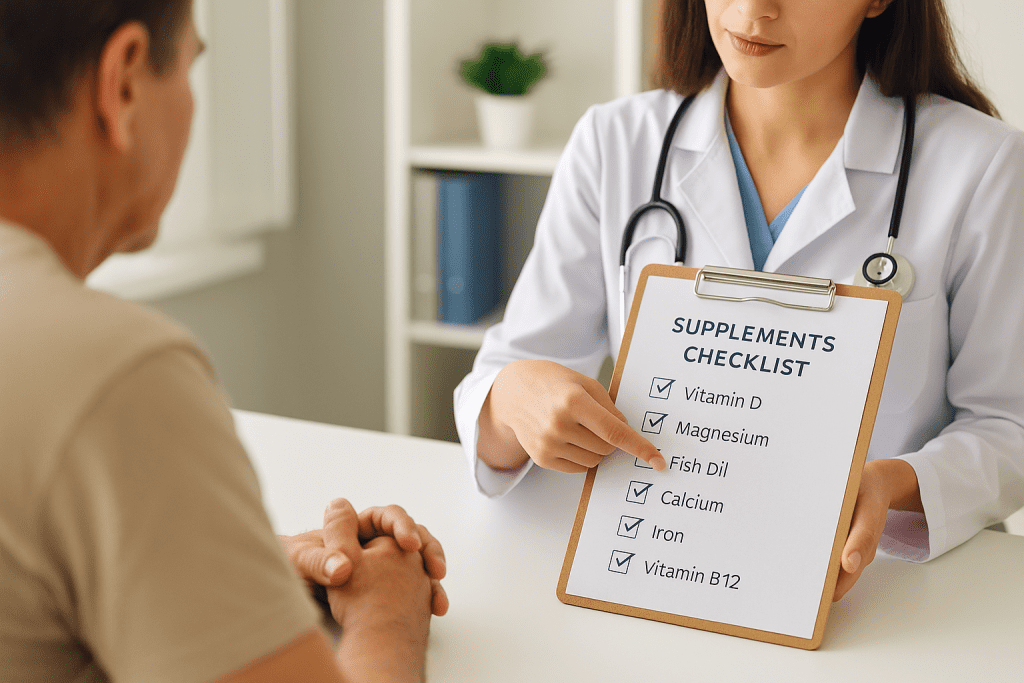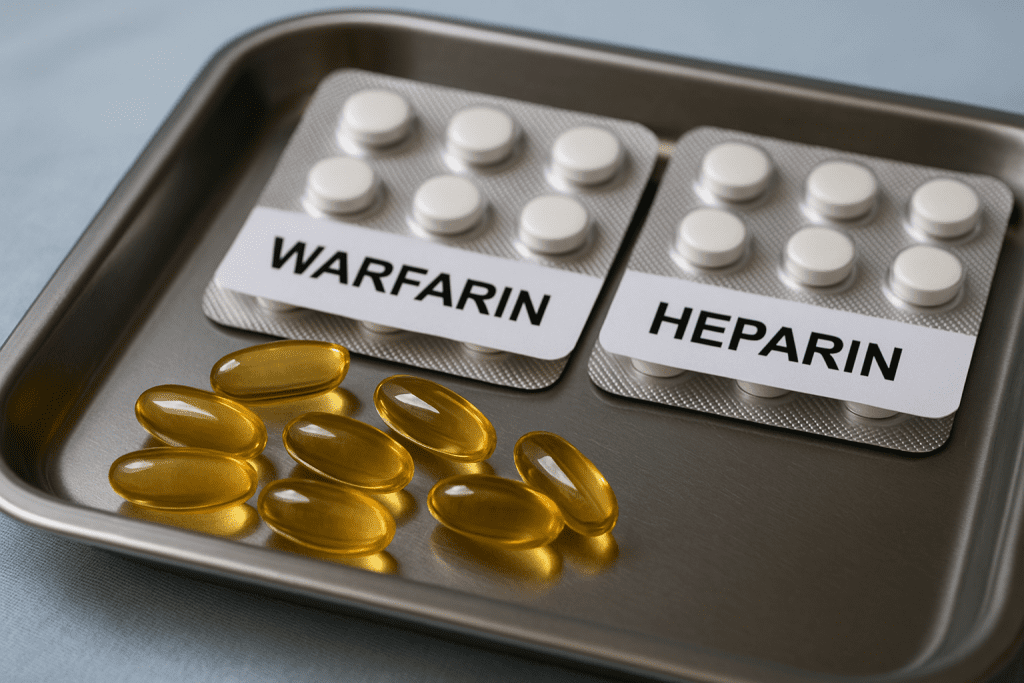If you’re taking a blood thinner like warfarin or heparin and also use vitamin E supplements, there’s an important interaction you should know about. Research has shown that high levels of vitamin E may increase your risk of bleeding, particularly when combined with anticoagulant medications.
This article breaks down how vitamin E affects blood clotting, the clinical evidence of its hemorrhagic potential, and what you can do to stay safe. Whether you’re managing heart health or eye conditions, knowing this interaction can help prevent serious complications.
Quick Summary: Does Vitamin E Increase Bleeding Risk with Blood Thinners?
- Yes, the interaction is real: Vitamin E may enhance the effects of blood thinners, increasing bleeding risk.
- Key mechanism: Inhibits platelet aggregation and interferes with vitamin K-dependent clotting.
- Risks rise with dosage: Doses over 400–800 IU/day show higher risk.
- Serum level matters: Bleeding risk rises when vitamin E/cholesterol ratio exceeds 5.5 µmol/mmol.
- Check with your doctor: Always consult before combining supplements with anticoagulants.
- Monitor signs of bleeding: Watch for easy bruising, hematuria, nosebleeds, or prolonged bleeding.
| Risk Factor | Impact |
|---|---|
| Vitamin E > 400 IU/day | Increased antiplatelet activity |
| Taking Warfarin | Higher INR levels, bleeding risk rises |
| Serum Vit E > 5.5 µmol/mmol | Significantly higher risk of major hemorrhage |
| Heparin Use + Vit E | Amplified blood thinning, need for caution |
How Vitamin E Affects Blood Clotting
Vitamin E, particularly in high doses, has been shown to affect the body’s coagulation system in multiple ways. It exerts anticoagulant and antiplatelet effects, which means it can reduce the blood’s ability to form clots.

Anticoagulant Properties
Vitamin E inhibits enzymes that depend on vitamin K, which is essential for the synthesis of clotting factors. It also suppresses tissue factor expression and platelet aggregation, particularly collagen-induced aggregation, by modulating oxidative stress pathways. A study published in Arteriosclerosis, Thrombosis, and Vascular Biology demonstrated that vitamin E significantly inhibits platelet activation by blunting hydrogen peroxide production.
These effects, while potentially beneficial in preventing cardiovascular events, become risky when combined with anticoagulant drugs.
Clinical Evidence of Bleeding Risk
Studies Linking Vitamin E and Warfarin
A Journal of the American Heart Association study analyzed patients with nonvalvular atrial fibrillation taking warfarin and found that those with higher serum vitamin E/cholesterol ratios were more likely to experience bleeding. The rate of bleeding increased progressively from those with minor to major events.
For example:
- Minor bleeding: 5.16±1.91 µmol/mmol cholesterol
- Major bleeding: 5.72±2.0 µmol/mmol cholesterol
This linear association held even after adjusting for other bleeding risk factors.
Interestingly, a smaller study in PubMed found no significant change in INR values with vitamin E supplementation. However, the sample size was limited, and broader studies have generally pointed to increased risk.
Real-World Case Reports
A notable case published by Wiley reported that a patient on 1200 IU/day of vitamin E experienced a retroperitoneal hemorrhage and hematuria shortly after starting supplementation while on warfarin. The patient had to discontinue both treatments temporarily.
Other reports document increased bleeding during or after surgery in patients who had taken vitamin E regularly, reinforcing concerns even with short-term use.
Vitamin E and Heparin: Less Studied, Still Concerning
While most data focuses on warfarin, there are also moderate interactions between vitamin E and heparin, including both low-molecular-weight and unfractionated forms. According to the Drugs.com Interaction Checker, vitamin E may increase the anticoagulant effect of heparin, although clinical trials are limited.
This suggests that caution is needed even when patients are on non-vitamin K antagonists. Anyone undergoing surgery or with a history of bleeding should be especially vigilant.
What Dosage of Vitamin E is Considered Safe?
Studies suggest that the risk of bleeding is dose-dependent, with higher doses (>400 IU/day) more likely to produce noticeable anticoagulant effects.
| Dosage Level | Risk Level |
| < 100 IU/day | Generally safe, low concern |
| 100–400 IU/day | Mild risk, monitor closely |
| 400–800 IU/day | Moderate risk, caution needed |
| > 800 IU/day | High risk, avoid without MD |
Some studies, including this PubMed article, found no significant changes in clotting at these levels, but others link even moderate doses to higher rates of hemorrhage. The variability often depends on patient-specific factors like age, comorbidities, and co-prescribed drugs.
Warning Signs to Watch For
If you’re combining vitamin E supplements with blood thinners, be alert to symptoms that may indicate internal or external bleeding:
- Unexplained bruising
- Prolonged nosebleeds
- Blood in urine or stool
- Dizziness or fatigue
- Bleeding gums
These signs warrant immediate medical attention, particularly if you’re on anticoagulant therapy.
How to Minimize Risk: Practical Recommendations

Talk to Your Doctor First
Before starting vitamin E, consult your physician, especially if you’re taking warfarin, heparin, aspirin, or NSAIDs. Monitoring INR or other coagulation parameters may be needed more frequently during supplementation.
Keep Dosage Consistent
Avoid large swings in vitamin E intake. If supplementation is deemed necessary, maintain a steady dose to prevent unexpected INR fluctuations.
Monitor Lab Values
Patients on warfarin should have INR checked more frequently when vitamin E is introduced or adjusted. Those using AREDS formulas that contain vitamin E should also inform their healthcare providers, as seen in this PMC case report.
Be Cautious with Other Supplements
Vitamin E is not the only supplement with potential anticoagulant effects. For example, saw palmetto and blood thinner interactions may also elevate bleeding risk. Similarly, potassium supplements and ACE inhibitor dangers are well-documented.
Conclusion
Vitamin E offers potential benefits as an antioxidant, but combining it with anticoagulant medications requires caution. Clinical studies and case reports consistently link high vitamin E levels to increased bleeding, particularly with warfarin. While some smaller trials offer mixed results, the weight of evidence supports close monitoring and medical consultation.
Always disclose supplement use to your healthcare provider and maintain consistent dosing if vitamin E is necessary. With proper oversight, you can reduce hemorrhage risk while preserving the therapeutic effects of your medications.
For more insights into supplement safety, check out our post on saw palmetto and blood thinner interactions.

